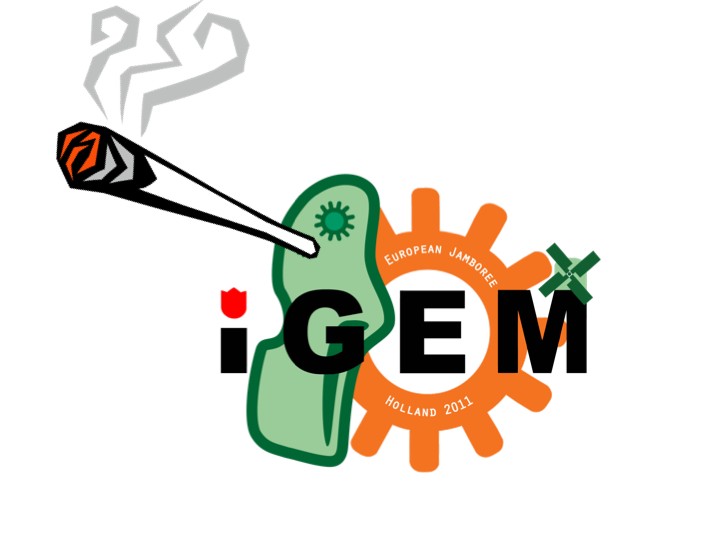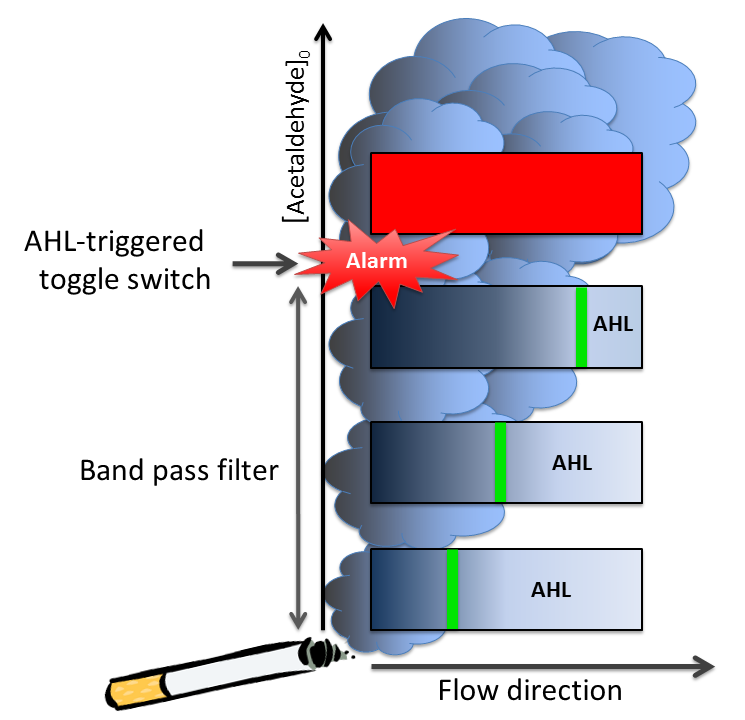Team:ETH Zurich/Project
From 2011.igem.org
(→Project description) |
(→Project description) |
||
| Line 61: | Line 61: | ||
Since our cells detect only a certain concentration range of acetaldehyde, as the gradient moves through the channel with varying initial concentration, the GFP stripe that certain cells produce will also "move along". Furthermore, our system acts as a low-pass filter which produces AHL molecules once the acetaldehyde concentration is below a certain threshold (the lower threshold for the previously described band-pass filter). Thus, cells that are on the right side of the GFP stripe will produce AHL (assuming the flow direction is from left to right). | Since our cells detect only a certain concentration range of acetaldehyde, as the gradient moves through the channel with varying initial concentration, the GFP stripe that certain cells produce will also "move along". Furthermore, our system acts as a low-pass filter which produces AHL molecules once the acetaldehyde concentration is below a certain threshold (the lower threshold for the previously described band-pass filter). Thus, cells that are on the right side of the GFP stripe will produce AHL (assuming the flow direction is from left to right). | ||
| - | As the stripe moves through the channel, AHL is always produced to its right and flows along in the channel. Moreover, we feed back some of the produced AHL to the channel again, by a "recycling channel", so that even the cells to the left of the stripe are supplied with AHL. As soon as the stripe moves to the end of the channel, no more cells produce AHL and the recycling ceases after a while. The absence of AHL then triggers RFP production by the entire culture. Thus, with increasing acetaldehyde concentration | + | As the stripe moves through the channel, AHL is always produced to its right and flows along in the channel. Moreover, we feed back some of the produced AHL to the channel again, by a "recycling channel", so that even the cells to the left of the stripe are supplied with AHL. As soon as the stripe moves to the end of the channel, no more cells produce AHL and the recycling ceases after a while. The absence of AHL then triggers RFP production by the entire culture. |
| + | |||
| + | Thus, with increasing acetaldehyde concentration in our channel one can see a moving green stripe. Once it reaches the end of the channel, the entire culture turns red. | ||
== Project Details== | == Project Details== | ||
Revision as of 13:56, 12 July 2011
| You can write a background of your team here. Give us a background of your team, the members, etc. Or tell us more about something of your choosing. | |
|
Tell us more about your project. Give us background. Use this is the abstract of your project. Be descriptive but concise (1-2 paragraphs) | File:ETH Zurich team.png Your team picture |
| Team Example |
| Home | Team | Official Team Profile | Project | Parts Submitted to the Registry | Modeling | Notebook | Safety | Attributions |
|---|
Contents |
Overall project
Idea
Our project focuses on the detection of cigarette smoke from the air by e.coli bacteria and monitoring its concentration visually by display of various lights. Our system will act as a smoke sensor and “partymeter”, telling us how a certain party progresses (under the creative assumption that the progress of the party is measured by the amount of smoke in the air).
Project description
We engineer our cells such that they can detect acetaldehyde, which is a substance found in cigarette smoke. Upon binding of acetaldehyde to AlcR, AlcR acts as an inhibitor of gene transcription. This is where our genetically engineered circuit starts. With a number of inhibitors and activators, our circuit gives rise to a GFP output upon sensing acetaldehyde in a certain range of concentration. Our circuit then acts as an acetaldehyde band-pass filter.
Our genetically engineered cells are cultivated in a microfluidic channel and are constantly supplied with a flow of growth medium containing acetaldehyde. They are designed to degrade acetaldehyde, such that a concentration gradient is created along the flow direction within the channel.
Since our cells detect only a certain concentration range of acetaldehyde, as the gradient moves through the channel with varying initial concentration, the GFP stripe that certain cells produce will also "move along". Furthermore, our system acts as a low-pass filter which produces AHL molecules once the acetaldehyde concentration is below a certain threshold (the lower threshold for the previously described band-pass filter). Thus, cells that are on the right side of the GFP stripe will produce AHL (assuming the flow direction is from left to right).
As the stripe moves through the channel, AHL is always produced to its right and flows along in the channel. Moreover, we feed back some of the produced AHL to the channel again, by a "recycling channel", so that even the cells to the left of the stripe are supplied with AHL. As soon as the stripe moves to the end of the channel, no more cells produce AHL and the recycling ceases after a while. The absence of AHL then triggers RFP production by the entire culture.
Thus, with increasing acetaldehyde concentration in our channel one can see a moving green stripe. Once it reaches the end of the channel, the entire culture turns red.
 "
"

